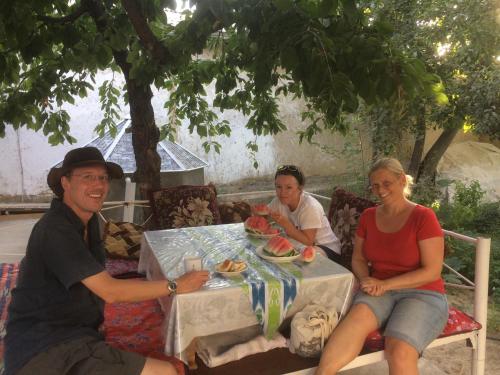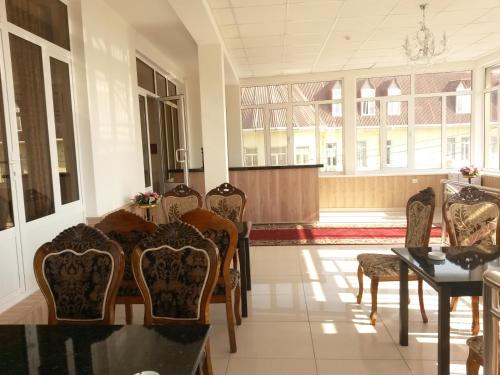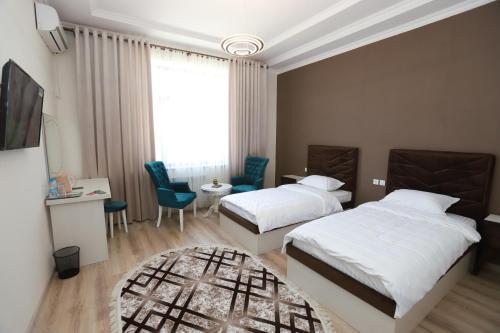Panajakent, Tajikistan
Panjakent is also often written as Penjikent. They are the same city in Tajikistan, just slightly different spellings of the translation of the original Persian name, which meant ‘five towns’.
Panjakent Market
Panjakent market is bustling and I feel like I’ve been caught in a riptide of floral-clad women with headscarves, pulled by their movement through the ornate gate into the site.
The morning rush is on and, across the market, plastic bags are being filled with fruits and vegetables, nuts and sweets.
As I wander, the crowd thins the further I go as the shoppers disperse to the different areas for particular items they’ve come to buy. The alley of clothes is quite quiet at the moment; the stalls with trays of grains are only slightly busier; but the vendors with the piles of circular breads are doing well.
Most of Panjakent market is open air, although the stalls and shops tend to have some kind of covering to keep off the sun (not the rain, which is rare). But at the centre is an enclosed circular building with two rings of interior columns.
The stalls inside are arranged in concentric circles and the sun shines in from high windows. It creates a spectacular effect that makes me think of the old bazaars of the Silk Road days.
And, in fact, Panjakent was an important Silk Road city, even if it wasn’t a particularly large one.
Its position at the very west of Tajikistan made it the last stop for caravans heading east from Samarkand to stock up before they hit the mountains – or, conversely, the first chance to rest for those that had just made the arduous trek across the peaks.
Ancient ruins in Panjakent
Standing at the top of the hill on the southern side, looking out across the valley, I can see the town of Panjakent (Penjikent) stretching out below me along the road that traces the path of the river.
That is the ‘new’ Panjakent, where you’ll find the central market and most of the shops and the houses.
Where I’m standing – or, more accurately, what I’m standing on top of – is the ancient city of Panjakent. The city is just ruins now and most of it is underground, still to be excavated, but it would once have been quite grand.
Ancient Panjakent was founded here as early as the 5th century BC as part of the Sogdian civilisation. It was in the 5th century AD that it really began to flourish, though.
The city would have grown significantly at that point, covering much of this elevated area that I’m wandering through. There would have been temples, fortresses, and large mansions for the wealthiest residents.
In 722 AD, though, the Arabs conquered Panjakent and that was the beginning of the end. By the end of the 8th century, it had been deserted.
It’s a shame, because it would be quite a spectacle to see more of Ancient Panjakent today. There have been excavations here for decades, so you can see some things (and it’s worth coming for a look) but it’s not as impressive as many other archaeological sites.
Even the artwork that has been found here – quite impressive frescoes, for instance – have been taken away to Dushanbe or St Petersburg. If you’re interested, there are a couple of originals in the museum on the main road of Panjakent and replicas in the small museum at the site of Ancient Panjakent.
When you visit the archaeological site, you should pop into the small building at the entrance to have a look not just at the artwork, but at some of the other artefacts that have been found here.
Things to do around Panjakent
Panjakent is rarely a destination in its own right. It is somewhere that, just like the travellers of the Silk Road, people stop to rest on a longer journey.
It’s on the road from Samarkand in Uzbekistan to Tajikistan’s capital, Dushanbe, or the nearby Fann Mountains or Seven Lakes.
But travellers do choose to visit Panjakent rather than any alternative because there are at least a few things to see here, such as the market, the ancient ruins, and the museum.
There are also a few other sights nearby that could be worth the time to visit as you are passing through.
Sarazm
The most significant thing to see near Panjakent is Sarazm, the remains of a city even more ancient than the one founded here by the Sogdians.
Sarazm was founded around 3500 BC and is most likely the oldest city in Central Asia. The people here became adept at agriculture and producing goods for trade, so it became an important an wealthy centre in the region.
When you visit these days, there are a few excavations to see, which give you some sense of how the people would’ve lived. But Sarazm would have once spread across about 90 hectares and most of it is still underground.
It may not be the most visually spectacular site you’ll see in this region but Sarazm is still very significant so I would suggest stopping for a look – it’s right on the main highway, so very easy to visit anyway.
Mausoleum of Mukhammad Bashoro
To the east of Panjakent, on a road off the main highway, you’ll find the Mausoleum of Mukhammad Bashoro in a small village called Mazari Sharif.
It was built here around the 11th or 12th centuries in honour of the Islamic scholar Mukhammad Bashoro that it’s named after, who was an expert in ‘khadises’.
The portal around the entrance was added around 1332. It’s one of the highlights of the site, with pink patterns of terracotta within a double frame of glazed turquoise bricks.
The mausoleum is small and it doesn’t take long to see but if you can use a translator to speak to the imam here, you’ll learn a lot of very interesting heritage about the building and the region.
Rudaki Mausoleum
Even further east, on the side road that you would take to the trekking base at Artuch, is the Rudaki Mausoleum.
This is much more modern than the other one I mentioned, and was built in 1958, but in the traditional style with a blue tiled dome on top. But it’s not the building that makes this an important landmark in Tajikistan – it’s the man it was built for.
Rudaki was a poet from the 9th century who is regarded as the first literary genius of the Modern Persian language. At the time, Persian was still being revitalised and didn’t have all the words and sounds to express the culture properly. He addressed this problem.
The mausoleum may seem in a strange place, not really near anything else, but that’s because it was built on the site where it’s believed he was buried, in the village where he was born.
As well as the mausoleum, there is a small one-room museum here about the poet’s life. You will probably need a translator to appreciate it, but it’s a nice way to learn more about this important national identity.
THE BEST ACCOMMODATION IN PANJAKENT
There are only a few places to stay in Panjakent, but at least there are some different styles to choose from.
BACKPACKER

The only backpacker place in town, Salom Hostel is a great social place, has a nice little garden, a kitchen, and clean rooms.
GUESTHOUSE

Although it’s an old building with basic facilities, Hotel SUGD & Guest House is very clean and has big rooms and hot showers.
HOTEL

The largest and most upmarket hotel, Panjakent Plaza has clean spacious rooms, English-speaking staff, and a free breakfast.
This publication is made possible by the support of the American People through the United States Agency for International Development (USAID) Competitiveness, Trade, and Jobs Activity in Central Asia. The contents of this publication are the sole responsibility of Time Travel Turtle and do not necessarily reflect the views of USAID or the United States Government.
This is my first-time to know about Panjakent! The place is so lovely! Thanks for sharing this, Michael!
My pleasure! I am glad you like the look of it. It’s an interesting little place to visit when you’re in Tajikistan.
I really enjoyed reading your article. Panjeket looks like a fantastic place to visit.
It sure is! Thanks for the comment – I appreciate you dropping by.
This is an awesome guide and the photos are awesome! I really enjoyed your visit to Panajakent, Tajikistan, your trip inspired me. I would like to follow your route …
Well, I hope you manage to get there one day! This part of the country is really fascinating!
The place is so lovely! Panjeket is a beautiful place and a must visit place!
Hi there,
Thanks so much for sharing. I can’t imagine how amazing it must have been to be there. I came across this page as I am just starting to teach virtual English class to students in Panjakent, and this is one of the few places with information online. Beautiful photos!
Happy travels and safe adventures wherever you are now.
Warmly,
Raia from Seattle
The Goddess Nana was honored as an ancient Eastern Iranian goddess worshiped by the Bactrians, Sogdians, and Chorasmians, as well as by non-Iranian Yuezhi, including Kushans, as the head of their respective pantheons. She was derived from the earlier Mesopotamian goddess Nanaya. Attempts to connect her with Inanna (Ishtar) instead depend on the erroneous notion that the latter is identical to Nanaya, which is considered outdated. She was regarded as an “Astral Deity” which means a divine immortal, and in Sogdian art, she was depicted representing both the Sun and Moon.
A mural from Bunjikat depicts the four-armed Nana seated on a lion which was a major cult center. Her Panjakent Symbol, the Crescent (in Bactria) representation of the sun and the moon. There is no consensus regarding the date of Nana’s introduction to Central Asia, though most researchers assume it occurred in the late first millennium BCE. She is the deity who grants Emperors their positions. Panjakent was most likely her cult center and a temple dedicated to her was located there.
She had Royal Power over the Kushan emperors, and in Sogdia she might have also developed an otherwise unattested warlike aspect like most Night Goddesses, as evidenced by murals showing her battling against demons. She was seemingly associated with the Sogdian counterpart of Tishtrya, Tish, who might have been regarded as her spouse.
Hi, do you know what kind of public transportation that go from Panjikent to Dushanbe?
Great post! I had no idea Panjakent had such a rich history and stunning landscapes. The recommendations for exploring the ancient ruins and local markets are really helpful. Can’t wait to visit and experience the culture firsthand!
I loved reading about Panjakent! The mix of history and natural beauty sounds amazing, especially the ancient ruins and the picturesque mountains. I can’t wait to explore the local culture and try the traditional food when I visit. Thanks for the recommendations!
This post about Panjakent is fantastic! I had no idea there was so much history and culture to explore there. The mention of the ancient ruins and beautiful landscapes has definitely inspired me to plan a visit. Thanks for sharing such detailed info!